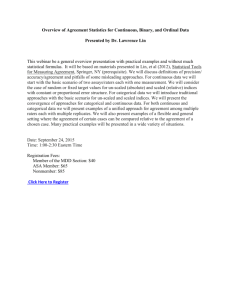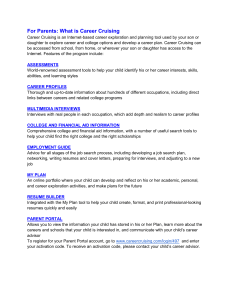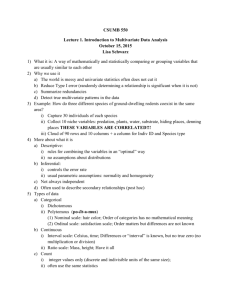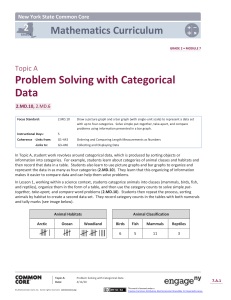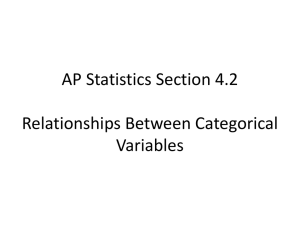Completed MYL/WE Grant Report Sample
advertisement
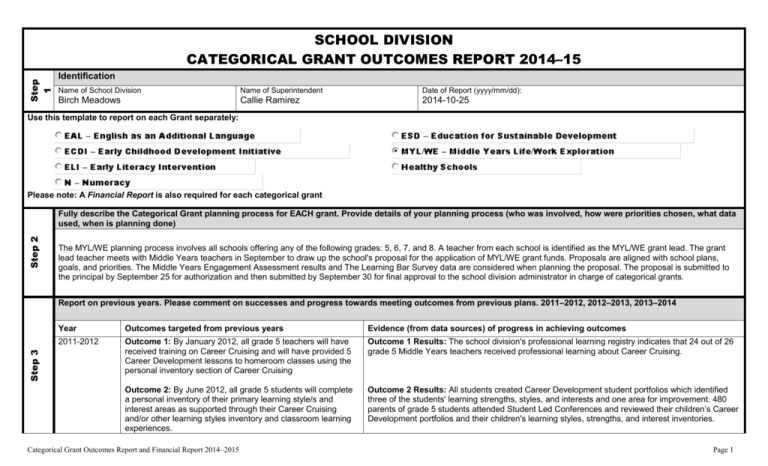
Step 1 SCHOOL DIVISION CATEGORICAL GRANT OUTCOMES REPORT 2014–15 Identification Name of School Division Name of Superintendent Date of Report (yyyy/mm/dd): Birch Meadows Callie Ramirez 2014-10-25 Use this template to report on each Grant separately: Please note: A Financial Report is also required for each categorical grant Step 2 Fully describe the Categorical Grant planning process for EACH grant. Provide details of your planning process (who was involved, how were priorities chosen, what data used, when is planning done) The MYL/WE planning process involves all schools offering any of the following grades: 5, 6, 7, and 8. A teacher from each school is identified as the MYL/WE grant lead. The grant lead teacher meets with Middle Years teachers in September to draw up the school's proposal for the application of MYL/WE grant funds. Proposals are aligned with school plans, goals, and priorities. The Middle Years Engagement Assessment results and The Learning Bar Survey data are considered when planning the proposal. The proposal is submitted to the principal by September 25 for authorization and then submitted by September 30 for final approval to the school division administrator in charge of categorical grants. Step 3 Report on previous years. Please comment on successes and progress towards meeting outcomes from previous plans. 2011–2012, 2012–2013, 2013–2014 Year Outcomes targeted from previous years Evidence (from data sources) of progress in achieving outcomes 2011-2012 Outcome 1: By January 2012, all grade 5 teachers will have received training on Career Cruising and will have provided 5 Career Development lessons to homeroom classes using the personal inventory section of Career Cruising Outcome 1 Results: The school division's professional learning registry indicates that 24 out of 26 grade 5 Middle Years teachers received professional learning about Career Cruising. Outcome 2: By June 2012, all grade 5 students will complete a personal inventory of their primary learning style/s and interest areas as supported through their Career Cruising and/or other learning styles inventory and classroom learning experiences. Outcome 2 Results: All students created Career Development student portfolios which identified three of the students' learning strengths, styles, and interests and one area for improvement. 480 parents of grade 5 students attended Student Led Conferences and reviewed their children’s Career Development portfolios and their children's learning styles, strengths, and interest inventories. Categorical Grant Outcomes Report and Financial Report 2014–2015 Page 1 2012-2013 2013-2014 Outcome 1: By January 2013, all grade 6 and 7 teachers will have received training on Career Cruising and will have provided 5 Career Development lessons to homeroom classes to explore 5 student selected career options described in Career Cruising Outcome 1 Results: The school division's professional learning registry indicates that 28 out of 29 grade 6 and 7 Middle Years teachers received professional learning about Career Cruising. Outcome 2: By June 2013, all grade 6 and 7 students will have created a personal interest record of 5 career options Outcome 2 Results: All grade 6 and 7 students created Career Development student portfolios which contained descriptions of 5 student-selected career options. 550 parents of grade 6 students and 468 parents of grade 7 students attended Student Led Conferences and reviewed with their children their children's personal interest records of 5 selected career options. Outcome 1 Results: The school division's professional learning registry indicates that 23 out of 25 grade 8 teachers received professional learning about Career Cruising. Outcome 1: By June 2014 all grade 8 teachers will have received training on Career Cruising. Outcome 2: By June 2014, all grade 8 students will have created a personal school/life timeline of strengths, successes, challenges, and goals and will have shared the timeline with their homeroom teacher and their parents. Outcome 2 Results: All grade 8 students created a school/life timeline of strengths, successes, challenges, and goals. 425 parents of grade 8 students attended Student Led Conferences and reviewed their children’s school/life timelines with them. Outcome 3: By the end of June 2014, all grade 8 students will have presented their personal school/life timelines at the June Grade 8 Exit Interviews attended by community and Senior Years school representatives. Outcome 3 Results: All grade 8 students presented their personal school/life timelines at the June Grade 8 Exit Interviews. 38 community and Senior Years representatives attended Exit Interviews and provided verbal and written feedback to students about the students' school/life timelines and students' presentation manner. Categorical Grant Outcomes Report and Financial Report 2014–2015 Page 2 2014–2015 Categorical Grants Plan Expected Learner Outcomes: Grant What are the benefits (specific, measurable, achievable, relevant, timely) for the learners? Step 4 Outcome 1: Middle Years students will be more familiar with their preferred learning style, strengths, and challenge areas. Student self-esteem and confidence will be improved through recognition that each student has a strength, interest, and skill that can be pursued and developed in school and life. Outcome 2: Middle Years students will be more aware of the connections between learning in the classroom and possible work/life options suited to them outside the classroom. Students will be exposed to a wide variety of role models who can support students' vision and goals for themselves and their futures. MYL/WE Note: Data Sources and Indicators columns are now combined to facilitate linkage of reporting in these areas. Data Sources and Indicators: Based on quantitative/qualitative data sources, what (measurable) evidence will show achievement of outcomes? Career Cruising personal inventory results will indicate students' strengths and interests and will include suggested jobs and careers that align with the students' identified strengths and interests Career Cruising student interest portfolios will demonstrate students’ understanding of their interest and strength areas and transition planning Inventory of researched career/work options that are of interest to students indicate an awareness of careers that may be in alignment with students’ interests and strengths Student surveys reflect awareness of personal preferences for planning for the future Parent feedback/exit slips after Student Led Conference sharing of students' Career Development learning indicate parents’ awareness of their children’s strengths, interests, and learning styles and preferences Strategies: What actions will be implemented to achieve outcomes? Differentiated instruction and student choice will allow for closer alignment between students' interests and strengths, and curricular and extracurricular outcomes. Parents invited to speak to students about their careers, occupations, hobbies, skills, interests, and/or volunteer experiences will increase students' awareness of school/postsecondary/career/work/life choices. Guest presenters share their backgrounds, stories, and perspectives about their chosen life and career/occupation paths. Career Fairs allow students to research a variety of careers and occupations and speak directly to representatives of those careers/occupations. Verbal and written feedback after grade 8 Exit Interviews indicate students’ increased awareness of their learning strengths, preferred learning styles, and goals Categorical Grant Outcomes Report and Financial Report 2014–2015 Page 3 Outcome 3: Middle Years students will be better prepared to make personal choices for course selections in Senior Years and school/work/postsecondary choices that have positive life and career-related consequences in their futures. Date: 2014-10-25 Student surveys indicate student interests and learning strengths Student portfolios reveal students’ understanding of their own successes, challenges, and transition planning Student school/life timelines indicate students’ successes and challenges Grade 9 teachers attend and present transition information at student assemblies and parent meetings, in order to inform students and parents of the choices and opportunities available in Senior Years. Division Contact: Hillary Ali Categorical Grant Outcomes Report and Financial Report 2014–2015 Page 4 School Division Categorical Grant Outcomes Report 2014–2015 Template Instructions 1. The latest templates are available at: <http://www.edu.gov.mb.ca/edu/grants.html> 2. Use the templates to submit the following reports: a. School Division Categorical Grant Outcomes Report b. Categorical Grant Review Financial Report 3. Report on each Categorical Grant using a separate Categorical Grant Outcomes Report. 4. Email reports to: <ruth.parnetta@gov.mb.ca>. The original signed Financial Report page must also be mailed to: Categorical Grant Review Early Childhood Education Unit 307-1181 Portage Avenue Winnipeg MB R3G OT3 5. A description of each grant can be found in the Funding of Schools 2014–2015 School Year. <http://www.edu.gov.mb.ca/k12/finance/schfund/index.html> and at <http://www.edu.gov.mb.ca/edu/grants.html>. Please note: The unexpended grant amounts from the ELI, N, MYL/WE, ECDI and ESD categorical grants will be applied as a reduction against the funding allocations calculated for 2014–2015. Categorical Grant Outcomes Report and Financial Report 2014–2015 Page 5
